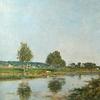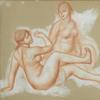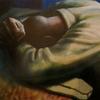Works by Kara Walker, Kehinde Wiley and Mickalene Thomas Among New Acquisitions in Joslyn Art Museum's Reopening of Postwar and Contemporary Galleries
- OMAHA, Nebraska
- /
- May 24, 2019
At a public opening event, Joslyn Art Museum unveiled five new contemporary acquisitions by American artists Rashid Johnson, Therman Statom, Mickalene Thomas, Kara Walker, and Kehinde Wiley. All five—two large paintings, a print triptych, and two mixed-media sculptures— are the first works by these selected artists to enter Joslyn’s permanent collection. They are now on view in the U.S. Bank/Rismiller Gallery (gallery 16).
The reopening of the four permanent collection galleries of postwar and contemporary art came following a brief closure that began May 7 at the conclusion of the exhibition 30 Americans. As that show was deinstalled, the spaces were prepared to reveal familiar favorites, as well as the new additions. Jack Becker, executive director & CEO, said, “We have planned for these acquisitions for some time now, and they reflect Joslyn’s commitment to diversifying the Museum’s holdings of works by women and artists of color. Many visitors were recently introduced to the work of Johnson, Thomas, Walker, and Wiley, as all four of these artists had work in 30 Americans. Therman Statom is a renowned sculptor, glass artist, and painter, working right here in Omaha. Each of these works is an incredible addition to the collection on its own. Together, they signal a fresh approach to collecting at Joslyn.”
Reinstallation Overview
In each of galleries 14, 15, 16, and 17, works will return to view, but organized in a new way. The Omaha World-Herald Gallery (gallery 14) includes work by artists such as Al Held, Frank Stella, Donald Judd, and Sol Lewitt, with the addition this summer of an installation by Jay Heikes, whose paintings will be featured in the Riley Contemporary Artists Project (CAP) Gallery (June 1–September 8). In gallery 15, visitors will experience a fresh approach to postwar abstraction. Large paintings by Helen Frankenthaler, Kenneth Noland, Gene Davis, and Robin Bruch will hang together for the first time. Gallery 17 will showcase work ranging from video installation to a selection of prints by some of the most important figures in Pop Art, including a recent anonymous gift of works by Jim Dine. Paintings by Philip Pearlstein, Rozeal (the inaugural CAP Gallery artist in 2014), Roger Shimomura, and Tom Wesselmann are highlights in this space. The five newly revealed acquisitions are all together in the U.S. Bank/Rismiller Gallery (gallery 16), along with 2016 works by El Anatsui, on loan to Joslyn from the collection of Annette and Paul Smith, and Hayv Kahraman, a refugee from Iraq who was featured in the CAP Gallery in 2016.
Karin Campbell, Phil Willson Curator of Contemporary Art at Joslyn, noted the impact of the reinstallation. “The new acquisitions, including those in recent years by CAP Gallery artists, provide important new avenues for reframing the collection of postwar and contemporary art. Yes, there are more artists who are women and artists of color, but even more important are the subjects of the work. Visitors will see more female subjects and more non-white subjects than have ever been found in Joslyn’s galleries before. It’s wonderful to reinstall galleries with art that is much more reflective of the diversity of our community. That is made possible by a collecting approach driven by the broader initiative to get the Museum looking much more like the America of today.”
Kehinde Wiley (American, b. 1977), Three Girls in a Wood, 2018, oil on linen, 108 x 144 in., 2018.11, Museum purchase, gift of The Sherwood Foundation. Courtesy of the artist and Roberts Projects, Los Angeles, California; Photo by Jean-Paul Torno, Courtesy Saint Louis Art Museum
Kehinde Wiley is known for his grand, Baroque-inspired canvases that celebrate and glorify black subjects. A native of South Central Los Angeles, Wiley began painting at the age of eleven and honed his abilities as an undergraduate at the San Francisco Art Institute before attending Yale University School of Art, where his interest in identity politics and issues of representation took root. Upon relocating to Harlem after completing his MFA, Wiley began making portraits of young black men who lived in his neighborhood. Basing his work on traditional European portraiture, his mission was to disrupt conventional portrait-painting, blur the lines between traditional and contemporary modes of representation, and elevate the black body.
Wiley created Three Girls in a Wood for his 2018 exhibition at Saint Louis Art Museum (SLAM). The artist found his subjects for the new paintings in north St. Louis and the nearby city of Ferguson, where the police shooting of Michael Brown, an unarmed black man, sparked protests in 2014. Wiley invited the selected participants to the museum, where he meticulously posed them based on works in the SLAM permanent collection. This painting is inspired by a 1920 canvas by German expressionist Otto Müller (1874-1930). Three Girls in a Wood continues Wiley’s use of elaborate floral settings, however the artist has introduced a new element: glowing light that seems to emanate from within the painting. Tinted by the vibrantly-colored backdrops, the light bathes Wiley’s subjects, bestowing them with an ethereal quality.
The St. Louis project marks a return to earlier subjects for Wiley, who dedicated the last several years to making portraits of other artists and notable black figures. This pursuit culminated with his official presidential portrait of Barack Obama, which was unveiled in February 2018 and is currently on view at the Smithsonian National Portrait Gallery in Washington, D.C.
Mickalene Thomas (American, born 1971), Din, une très belle négresse 1, 2012, rhinestones, acrylic, oil, and enamel on wood panel, 102 x 84 x
2 in., 2019.6, Museum purchase, gift of The Sherwood Foundation
Drawing on seemingly disparate sources, including European portraiture and landscape painting, 1970s Blaxploitation films, and current popular culture, Mickalene Thomas creates paintings, photographs, prints, and videos that foreground black femininity, while confronting contemporary understandings of beauty and sexuality. The artist depicts empowered, glamorous, and self-assured women who embrace both their gender and the color of their skin.
A native of Camden, New Jersey, Thomas received her BFA from Pratt Institute, Brooklyn, and her MFA from Yale University School of Art, New Haven. She grounds her approach to portraiture in the work of some of the most influential painters and collage artists of the nineteenth and twentieth centuries, including Pablo Picasso, Henri Matisse, Edouard Manet, and Romare Bearden. Often mimicking the classic poses favored by these masters, Thomas seeks to reclaim agency for women, who have long been viewed in the art context as either muses or objects to be desired and consumed.
The title of this painting, Din, une très belle négresse 1, translates from French to “Din, a beautiful black woman.” Sporting an afro and vibrant make-up, Thomas’ subject invites—and perhaps even challenges—the viewer’s gaze. As with much of Thomas’ work, this painting juxtaposes elaborate decorative patterning with the human form. Thomas completes this stately portrait by bestowing her subject with earrings and a prominent necklace, which, along with the subject’s lips, are adorned with glittering rhinestones.
Kara Walker (American, b. 1969), Resurrection Story with Patrons, 2017, etching with aquatint, sugar-lift, spit-bite, and dry-point on Hahnemuhle Copperplate Bright White 400gsm paper, 39 ¾ x 30 in.; 39 ¾ x 49 in., 39 ¾ x 30 in., 2018.1a-c, Museum purchase, General Art Endowment Fund
For more than twenty years, Kara Walker has been one of the most potent voices in contemporary art, addressing the intersections of race, gender, sexuality, and violence. Walker received a BFA from Atlanta College of Art and an MFA from the Rhode Island School of Design. She came to international attention in the 1990s for her scenes of the Antebellum South, narrated by silhouetted figures collaged from cut paper or vinyl. Borrowing a portraiture format popular during the Victorian Era, Walker populates her silhouette tableaux with images portraying acts of violence against the black body, particularly the female black body. Taking history as it is written as her starting point, Walker proposes alternative narratives for communities of color in the United States, asking: “What power do I have to examine the depth of longing people of color have for a sense of place and purpose in reimagining our collective past and
potential future?”
Resurrection Story with Patrons grew out of a series of charcoal drawings Walker created during a residency at the American Academy in Rome in 2016. In this triptych, which takes the form of an altar piece with “patrons” flanking the central image, a black body emerges from the destruction of a shipwreck with the assistance of others who pull her upright with ropes and support her as she rises. Accepting the help of those who toil to lift her, Walker’s resurrection figure is a reminder that the task that Black Americans face on a daily basis of simply surviving may only be possible with support of those willing to work toward equality and justice.
Rashid Johnson (American, b. 1977), Untitled Microphone Sculpture, 2018, bronze, ceramic tile, mirror tile, shea butter, black soap, and wax, 60 x 60 x 6 1/8 in., 2018.4, Museum purchase, Baumgarten Art Endowment Fund
Rashid Johnson belongs to a generation of young African American artists who emerged in the early 2000s. Loosely identified as “post-black,” they contend that “blackness” encompasses a range of realities. Johnson received his BA from Columbia College, Chicago, and his MFA from the School of the Art Institute of Chicago. Expanding upon art historical traditions of painting and collage, and drawing inspiration from writers and poets, he employs materials, objects, and processes that have both personal and shared cultural significance. Johnson charts a distinct path that directly engages audiences and compels them to be active participants in his work and, by extension, in society.
Untitled Microphone Sculpture is part of a series that considers the power of the amplified voice. Modeled in the tradition of a Robert Rauschenberg-style assemblage, this bronze-framed work features panels pieced together like a puzzle. Employing unconventional materials, including shea butter, wax, and black soap, a West African cleanser that receives its color from the ashes of burned plants, Johnson explores expressive mark-making that builds on the tradition of gestural abstraction in American painting. Hidden at the center of the work is a functioning microphone connected to a speaker. Viewers are encouraged to “talk” to the sculpture, allowing their words to be projected into the gallery space. Once activated, the work meditates on the balance between solitude and social immersion, both essential for a productive society and robust democracy.
Therman Statom (American, born 1953), Untitled, 2009, glass and mixed media, 50 ½ x 40 x 5 in., 2019.1, Museum purchase, gift of the Ephraim L. Marks and David M. Rice Art Collection, by exchange
Omaha-based sculptor, glass artist, and painter Therman Statom is a pioneer of the contemporary glass movement. Gluing sections of plate glass to one another, Statom creates a variety of forms, including large-scale ladders, chairs, tables, mixed media shadowboxes, and miniature houses. While these objects evoke a Minimalist aesthetic, Statom’s handling of paint draws on the intuitive approach favored by the Abstract Expressionists. The artist often sandblasts the surfaces of his constructions, allowing them to become canvases for lively compositions composed of vibrant colors and playful lines. Illustrating Statom’s skill with multiple glass-working techniques, his sculptures often include blown-glass elements, as seen in several compartments in this untitled box. Like many of his shadowboxes, this work also incorporates found objects and images, giving it the enigmatic appearance of a cabinet of curiosities.







__Portrait_of_a_Young_100x100_c.jpg)






